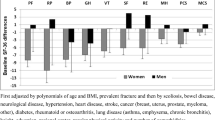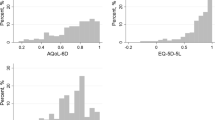Abstract
The objective of this research was to determine the relative decrement in health-related quality of life, as measured by the health utilities index mark 3 (HUI3), in osteoporosis compared to other chronic medical conditions. The impact of chronic medical conditions other than osteoporosis on HUI3 measurements had been previously established in the 1996/1997 Canadian National Population Health Survey (NPHS). The Canadian Multicentre Osteoporosis Study (CaMos) is a national population-based study in which regional participants were randomly recruited, regardless of presence of osteoporosis. We analyzed data from participants aged ≥65 years who completed a baseline HUI3 questionnaire and provided information on their medical history (n=3,750). We determined the age- and gender-adjusted mean decrement in HUI3 for several chronic medical conditions, including osteoporosis. The mean changes in HUI3 adjusted for age and gender (with 95% confidence intervals) were as follows: arthritis −0.10 (−0.11, −0.09), chronic obstructive pulmonary disease (COPD) −0.07 (−0.09, -0.05), diabetes mellitus −0.05 (−0.08, −0.03), heart disease −0.06 (-0.08, −0.04), hypertension −0.02 (-0.03, −0.01), and osteoporosis −0.08 (−0.11, −0.06), respectively (model r2=0.17; P<0.0001). These findings were comparable to those observed in the NPHS, with the exception of osteoporosis, which had not been previously studied in this fashion. The decrement in HUI3 score seen in participants with osteoporosis was comparable to that observed in other chronic medical conditions, such as arthritis, COPD, diabetes mellitus or heart disease.
Similar content being viewed by others
References
NIH Consensus Development Panel on Osteoporosis Prevention, Diagnosis and Therapy (2001) Osteoporosis prevention, diagnosis and therapy. JAMA 285:785–795
Jackson SA, Tenenhouse A, Robertson L (2000) Vertebral fracture definition from population-based data: preliminary results from the Canadian Multicentre Osteoporosis Study (CaMos). Osteoporos Int 11:680–687
Cree M, Soskolne CL, Belseck E, Hornig J, McElhaney JE, Brant R, Suarez-Almazor M (2000) Mortality and institutionalization following hip fracture. J Am Geriatr Soc 48:283–288
Cauley JA, Thompson DE, Ensrud KC, Scott JC, Black D (2000) Risk of mortality following clinical fractures. Osteoporos Int 11:556–561
Davidson CW, Merrilees MJ, Wilkinson TJ, McKie JS, Gilchrist NL (2001) Hip fracture mortality and morbidity—can we do better? N Z Med J 114:329–332
Haczynski J, Jakimiuk A (2001) Vertebral fractures: a hidden problem of osteoporosis. Med Sci Monit 7:1108–1117
Kanis JA, Oden A, Johnell O, De Laet C, Jonsson B, Oglesby AK (2003) The components of excess mortality after hip fracture. Bone 32:468–473
Leibson CL, Tosteson AN, Gabriel SE, Ransom JE, Melton LJ (2002) Mortality, disability, and nursing home use for persons with and without hip fracture: a population-based study. J Am Geriatr Soc 50:1644–1650
Papaioannou A, Adachi JD, Parkinson W, Stephenson G, Bedard M (2001) Lengthy hospitalization associated with vertebral fractures despite control for comorbid conditions. Osteoporos Int 12(10)870–874
Papaioannou A, Watts NB, Kendler DL, Yuen CK, Adachi JD, Ferko N (2002) Diagnosis and management of vertebral fractures in elderly adults. Am J Med 113:220–228
Kreiger N, Tenenhouse A, Joseph L, Mackenzie T, Poliquin S, Brown JP, Prior JC, Rittmaster RS (1999) The Canadian Multicentre Osteoporosis Study (CaMos): background, rationale, methods. Can J Aging 18:376–387
Adachi JD, Ioannidis G, Pickard L, Berger C, Prior JC, Joseph L, Hanley DA, Olszynski WP Murray TM, Anastassiades T, Brown JP, Kirkland S, Joyce C, Papaioannou A, Poliquin S, Tenenhouse A, Papadimitropoulos EA, and the Canadian Multicentre Osteoporosis Study (CaMos) research group (2003) the association between osteoporotic fractures and health-related quality of life as measured by the health utilities index in the Canadian Multicentre Osteoporosis Study (CaMos). Osteoporos Int 14:895–904
Schultz SE, Kopec JA (2003) Impact of chronic conditions. Health Rep 14:41–53
Feeny D, Furlong W, Torrance GW, Goldsmith CH, Zhu Z, DePauw S, Denton M, Boyle M (2002) Multiattribute and single-attribute utility functions for the health utilities index mark 3 system. Med Care 40:113–128
Furlong WJ, Feeney DH, Torrance GW, Barr RD (2001) The health utilities index (HUI) system for assessing health-related quality of life in clinical studies. Ann Med 33:375–385
Horsman J, Furlong W, Feeny D, Torrance (2003) The health utilities index (HUI): concepts, measurement properties and applications. Health Qual Life Outcome 1:54
Kmetic A, Joseph L, Berger C, Tenenhouse A (2002) Multiple imputation to account for missing data in a survey: estimating the prevalence of osteoporosis. Epidemiology 13:437–444
Simpson CF, Boyd CM, Carlson MC, Griswold ME, Guralnik JM, Fried LP (2004) Agreement between self-report of disease diagnoses and medical record validation in disabled older women: factors that modify agreement. J Am Geriatr Soc 52:123–127
Brazier JE, Green C, Kanis JA, on behalf of the Committee of Scientific Advisors, International Osteoporosis Foundation (2002) A systematic review of health state utility values for osteoporosis-related conditions. Osteoporos Int 13:768–776
Acknowledgements
The Canadian Multicentre Osteoporosis Study was funded by the Senior’s Independent Research Program, through the National Health Research and Development Program of Canada (project no. 6605-4003-OS); the Medical Research Council of Canada, MRC-PMAC Health Program; Merck Frosst Canada, Inc.; Eli Lilly Canada, Inc.; Procter and Gamble Pharmaceuticals Canada, Inc.; Aventis Pharma Inc.; Novartis Inc.; and the Dairy Farmers of Canada. We would like to thank the CaMos Publication Committee for thoughtful reviews of our analysis plan and results.
Author information
Authors and Affiliations
Corresponding author
Additional information
This article was written with the participation of the CaMos Investigators: T. Anastassiades, L. Bissette, J.P. Brown, L. Joseph, R.G. Josse, C. Joyce, S. Kaiser, S. Kirkland, N. Kreiger, T.M. Murray, W.P. Olszynski, J. Prior, K. Siminoski, S. Poliquin, A. Tenenhouse
Rights and permissions
About this article
Cite this article
Sawka, A.M., Thabane, L., Papaioannou, A. et al. Health-related quality of life measurements in elderly Canadians with osteoporosis compared to other chronic medical conditions: a population-based study from the Canadian Multicentre Osteoporosis Study (CaMos). Osteoporos Int 16, 1836–1840 (2005). https://doi.org/10.1007/s00198-005-1949-6
Received:
Accepted:
Published:
Issue Date:
DOI: https://doi.org/10.1007/s00198-005-1949-6




